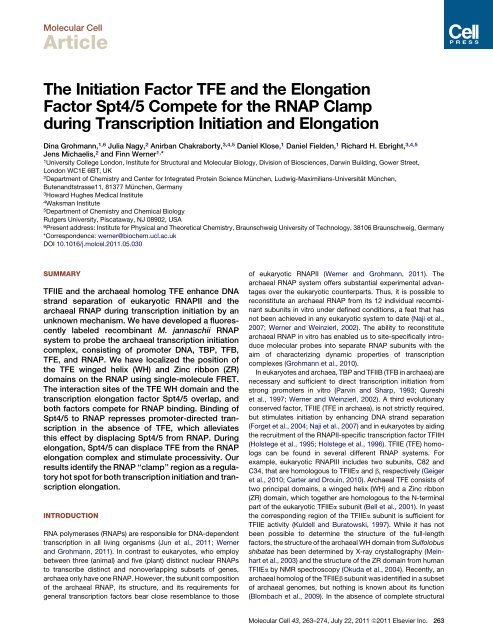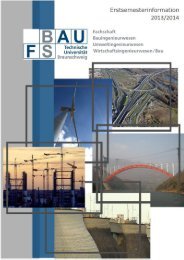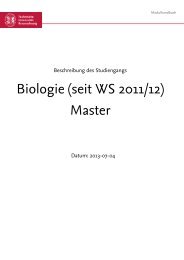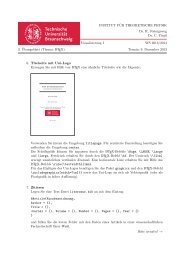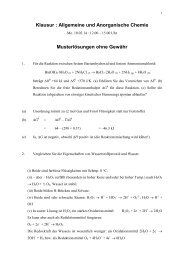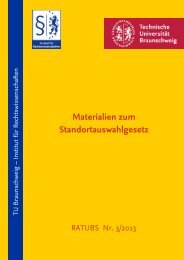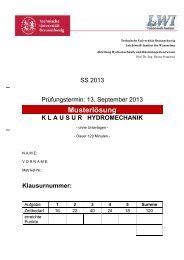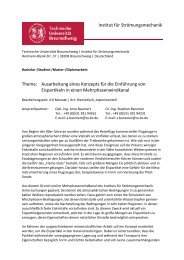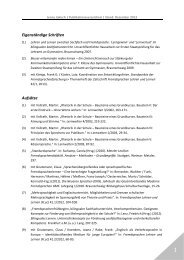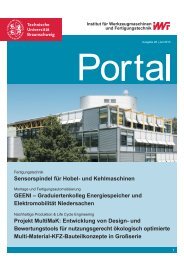L - Technische Universität Braunschweig
L - Technische Universität Braunschweig
L - Technische Universität Braunschweig
Create successful ePaper yourself
Turn your PDF publications into a flip-book with our unique Google optimized e-Paper software.
Molecular Cell<br />
Article<br />
The Initiation Factor TFE and the Elongation<br />
Factor Spt4/5 Compete for the RNAP Clamp<br />
during Transcription Initiation and Elongation<br />
Dina Grohmann, 1,6 Julia Nagy, 2 Anirban Chakraborty, 3,4,5 Daniel Klose, 1 Daniel Fielden, 1 Richard H. Ebright, 3,4,5<br />
Jens Michaelis, 2 and Finn Werner 1, *<br />
1<br />
University College London, Institute for Structural and Molecular Biology, Division of Biosciences, Darwin Building, Gower Street,<br />
London WC1E 6BT, UK<br />
2<br />
Department of Chemistry and Center for Integrated Protein Science München, Ludwig-Maximilians-<strong>Universität</strong> München,<br />
Butenandtstrasse11, 81377 München, Germany<br />
3<br />
Howard Hughes Medical Institute<br />
4<br />
Waksman Institute<br />
5<br />
Department of Chemistry and Chemical Biology<br />
Rutgers University, Piscataway, NJ 08902, USA<br />
6<br />
Present address: Institute for Physical and Theoretical Chemistry, <strong>Braunschweig</strong> University of Technology, 38106 <strong>Braunschweig</strong>, Germany<br />
*Correspondence: werner@biochem.ucl.ac.uk<br />
DOI 10.1016/j.molcel.2011.05.030<br />
SUMMARY<br />
TFIIE and the archaeal homolog TFE enhance DNA<br />
strand separation of eukaryotic RNAPII and the<br />
archaeal RNAP during transcription initiation by an<br />
unknown mechanism. We have developed a fluorescently<br />
labeled recombinant M. jannaschii RNAP<br />
system to probe the archaeal transcription initiation<br />
complex, consisting of promoter DNA, TBP, TFB,<br />
TFE, and RNAP. We have localized the position of<br />
the TFE winged helix (WH) and Zinc ribbon (ZR)<br />
domains on the RNAP using single-molecule FRET.<br />
The interaction sites of the TFE WH domain and the<br />
transcription elongation factor Spt4/5 overlap, and<br />
both factors compete for RNAP binding. Binding of<br />
Spt4/5 to RNAP represses promoter-directed transcription<br />
in the absence of TFE, which alleviates<br />
this effect by displacing Spt4/5 from RNAP. During<br />
elongation, Spt4/5 can displace TFE from the RNAP<br />
elongation complex and stimulate processivity. Our<br />
results identify the RNAP ‘‘clamp’’ region as a regulatory<br />
hot spot for both transcription initiation and transcription<br />
elongation.<br />
INTRODUCTION<br />
RNA polymerases (RNAPs) are responsible for DNA-dependent<br />
transcription in all living organisms (Jun et al., 2011; Werner<br />
and Grohmann, 2011). In contrast to eukaryotes, who employ<br />
between three (animal) and five (plant) distinct nuclear RNAPs<br />
to transcribe distinct and nonoverlapping subsets of genes,<br />
archaea only have one RNAP. However, the subunit composition<br />
of the archaeal RNAP, its structure, and its requirements for<br />
general transcription factors bear close resemblance to those<br />
of eukaryotic RNAPII (Werner and Grohmann, 2011). The<br />
archaeal RNAP system offers substantial experimental advantages<br />
over the eukaryotic counterparts. Thus, it is possible to<br />
reconstitute an archaeal RNAP from its 12 individual recombinant<br />
subunits in vitro under defined conditions, a feat that has<br />
not been achieved in any eukaryotic system to date (Naji et al.,<br />
2007; Werner and Weinzierl, 2002). The ability to reconstitute<br />
archaeal RNAP in vitro has enabled us to site-specifically introduce<br />
molecular probes into separate RNAP subunits with the<br />
aim of characterizing dynamic properties of transcription<br />
complexes (Grohmann et al., 2010).<br />
In eukaryotes and archaea, TBP and TFIIB (TFB in archaea) are<br />
necessary and sufficient to direct transcription initiation from<br />
strong promoters in vitro (Parvin and Sharp, 1993; Qureshi<br />
et al., 1997; Werner and Weinzierl, 2002). A third evolutionary<br />
conserved factor, TFIIE (TFE in archaea), is not strictly required,<br />
but stimulates initiation by enhancing DNA strand separation<br />
(Forget et al., 2004; Naji et al., 2007) and in eukaryotes by aiding<br />
the recruitment of the RNAPII-specific transcription factor TFIIH<br />
(Holstege et al., 1995; Holstege et al., 1996). TFIIE (TFE) homologs<br />
can be found in several different RNAP systems. For<br />
example, eukaryotic RNAPIII includes two subunits, C82 and<br />
C34, that are homologous to TFIIEa and b, respectively (Geiger<br />
et al., 2010; Carter and Drouin, 2010). Archaeal TFE consists of<br />
two principal domains, a winged helix (WH) and a Zinc ribbon<br />
(ZR) domain, which together are homologous to the N-terminal<br />
part of the eukaryotic TFIIEa subunit (Bell et al., 2001). In yeast<br />
the corresponding region of the TFIIEa subunit is sufficient for<br />
TFIIE activity (Kuldell and Buratowski, 1997). While it has not<br />
been possible to determine the structure of the full-length<br />
factors, the structure of the archaeal WH domain from Sulfolobus<br />
shibatae has been determined by X-ray crystallography (Meinhart<br />
et al., 2003) and the structure of the ZR domain from human<br />
TFIIEa by NMR spectroscopy (Okuda et al., 2004). Recently, an<br />
archaeal homolog of the TFIIEb subunit was identified in a subset<br />
of archaeal genomes, but nothing is known about its function<br />
(Blombach et al., 2009). In the absence of complete structural<br />
Molecular Cell 43, 263–274, July 22, 2011 ª2011 Elsevier Inc. 263


